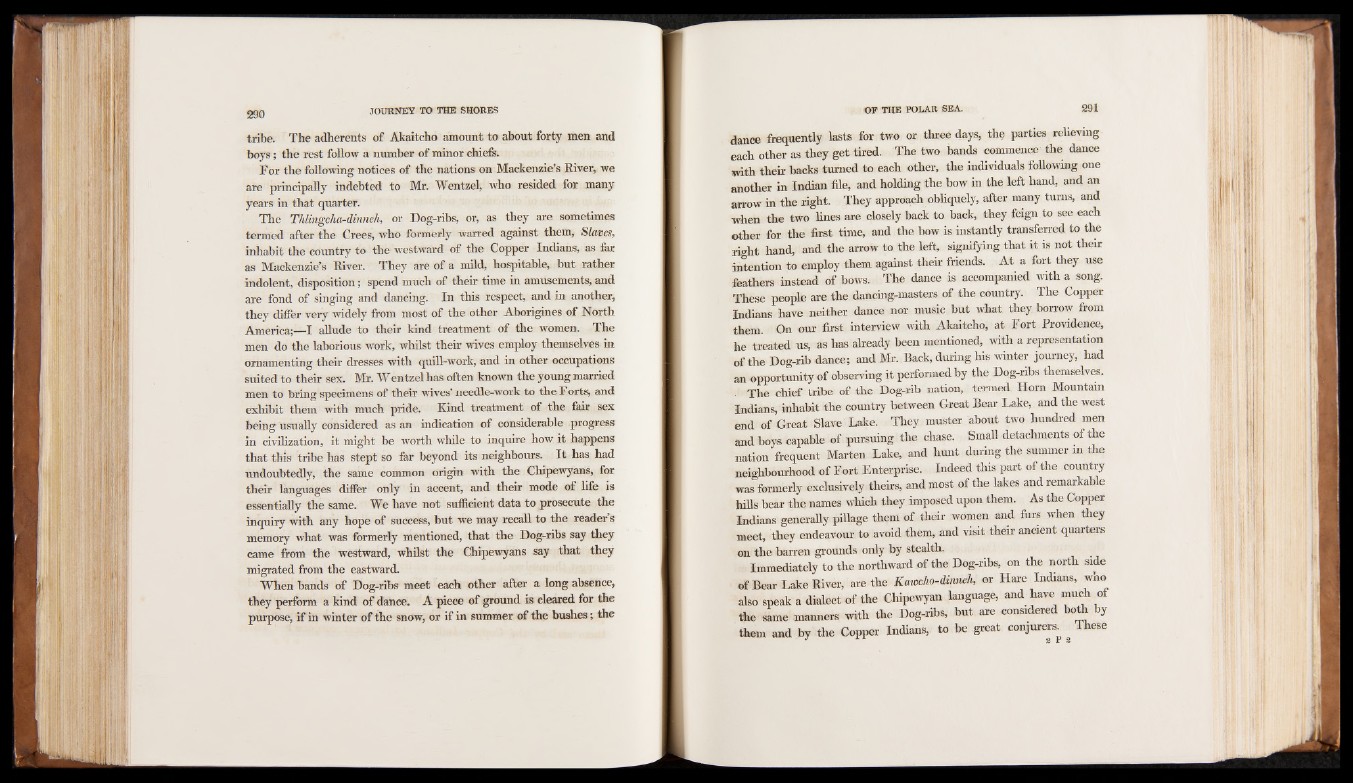
tribe. The adherents of Akaitcho amount to about forty men and
boys; the rest follow a number of minor chiefs.
For the following notices of the nations on Mackenzie’s River, we
are principally indebted to Mr. Wentzel, who resided for many
years in that quarter.
The Thlingcha-dinneh, or Dog-ribs, or, as they are sometimes
termed after the Crees, who formerly warred against them, Simses,
inhabit the country to the westward of the Copper Indians, as for
as Mackenzie’s River. They are of a mild, hospitable, but rather
indolent, disposition; spend much of their time in amusements, and
are fond of singing and dancing. In this respect, and in another,
they differ very widely from most of the other Aborigines of North
America;—I allude to their kind treatment of the women. The
men do the laborious work, whilst their wives employ themselves in
ornamenting their dresses with quill-work, and in other occupations
suited to their sex. Mr. Wentzel has often known the young married
men to bring specimens of their wives’ needle-work to the Forts, and
exhibit them with much pride. Kind treatment of the fair sex
being usually considered as an indication of considerable progress
in civilization, it might be worth while to inquire how it happens
that this tribe has stept so far beyond its neighbours. It has had
undoubtedly, the same common origin with the Chipewyans, far
their languages differ only in accent, and their mode of life is
essentially the same. We have not sufficient data to prosecute the
inquiry with any hope of success, but we may recall to the readers
memory what was formerly mentioned, that the Dog-ribs say they
came from the westward, whilst the Chipewyans say that they
migrated from the eastward.
When bands of Dog-ribs meet each other after a long absence,
they perform a kind of dance. A piece of ground is cleared for the
purpose, if in winter of the snow, or if in summer of the bushes; the
dance frequently lasts for two or three days, the parties relieving
each other as they get tired. The two bands commence the dance
with their backs turned to each other, the individuals following one
another in Indian file, and holding the bow in the left hand, and an
arrow in the right. They approach obliquely, after many turns, and
when the two lines are closely back to back, they feign to see each
other for the first time, and the bow is instantly transferred to the
right hand, and the arrow to the left, signifying that it is not them
intention to employ them against their friends. At a fort they use
feathers instead of bows. The dance is accompanied with a song.
These people are the dancing-masters of the country. The Copper
Indians have neither dance nor music but what they borrow from
them. On our first interview with Akaitcho, at Fort Providence,
he treated us, as has already been mentioned, with a representation
of the Dog-rib dance; and Mr. Back, during his winter journey, had
an opportunity of observing it performed by the Dog-ribs themselves.
The chief tribe of the Dog-rib nation, termed Horn Mountain
Indians, inhabit the country between Great Bear Lake, and the west
end of Great Slave Lake. They muster about two hundred men
and boys capable of pursuing the chase. Small detachments of the
nation frequent Marten Lake, and hunt during the summer m the
neighbourhood of Fort Enterprise. Indeed this part of the country
was formerly exclusively theirs, and most of the lakes and remarkable
hills bear the names which they imposed upon them. As the Copper
Indians generally pillage them of their women and furs when they
meet, they endeavour to avoid them, and visit their ancient quarters
on the barren grounds only by stealth.
Immediately to the northward of the Dog-ribs, on the north side
of Bear Lake River, are the Kaiocho-dimeh, or Hare Indians, wno
also speak a dialect of the Chipewyan language, and have much ot
the same manners with the Dog-ribs, but are considered both by
them and by the Copper Indians, to be great conjurers^ These